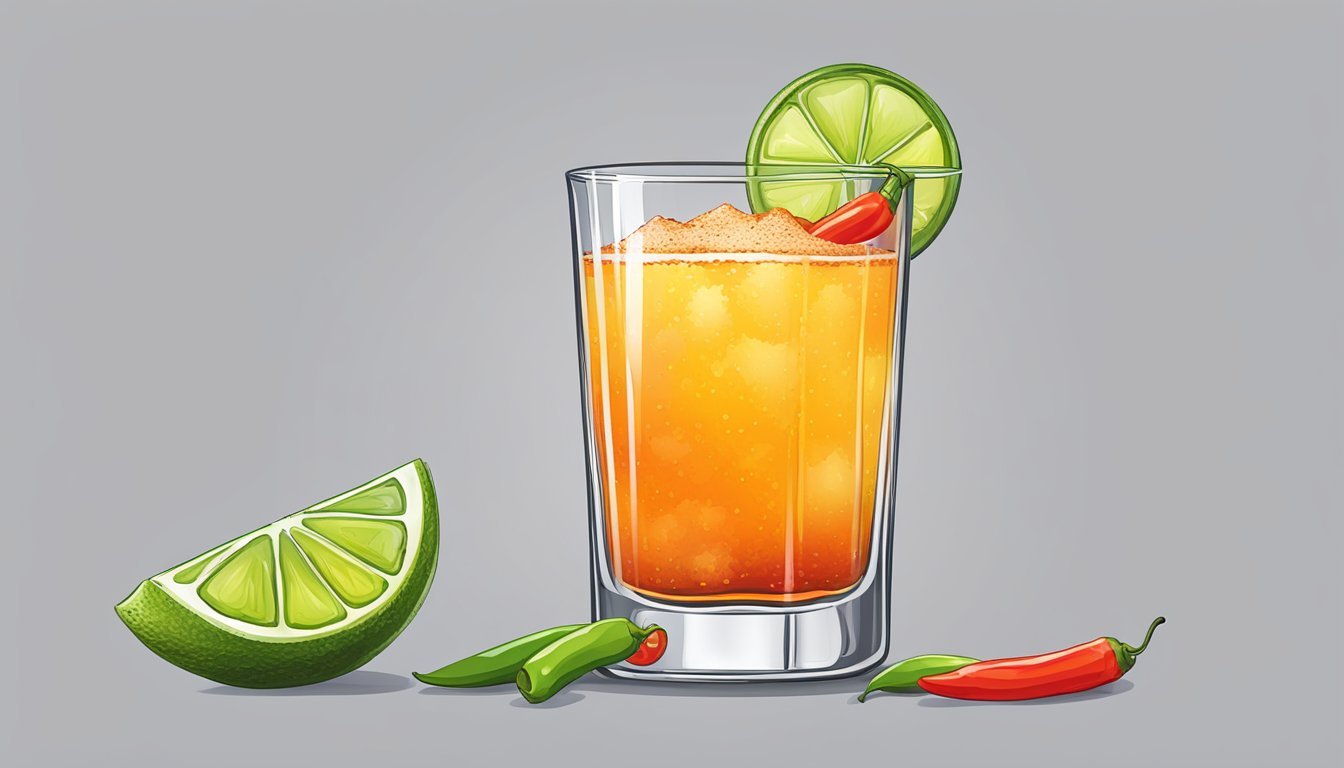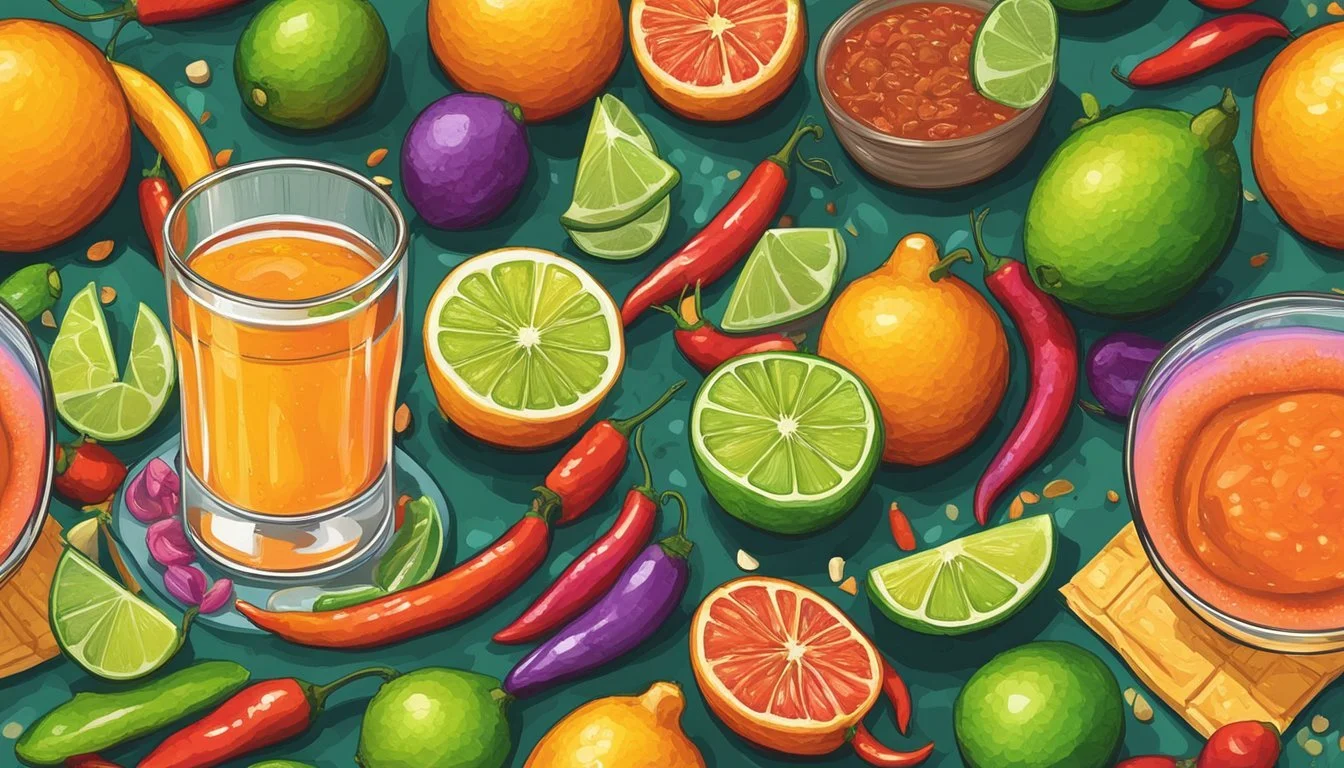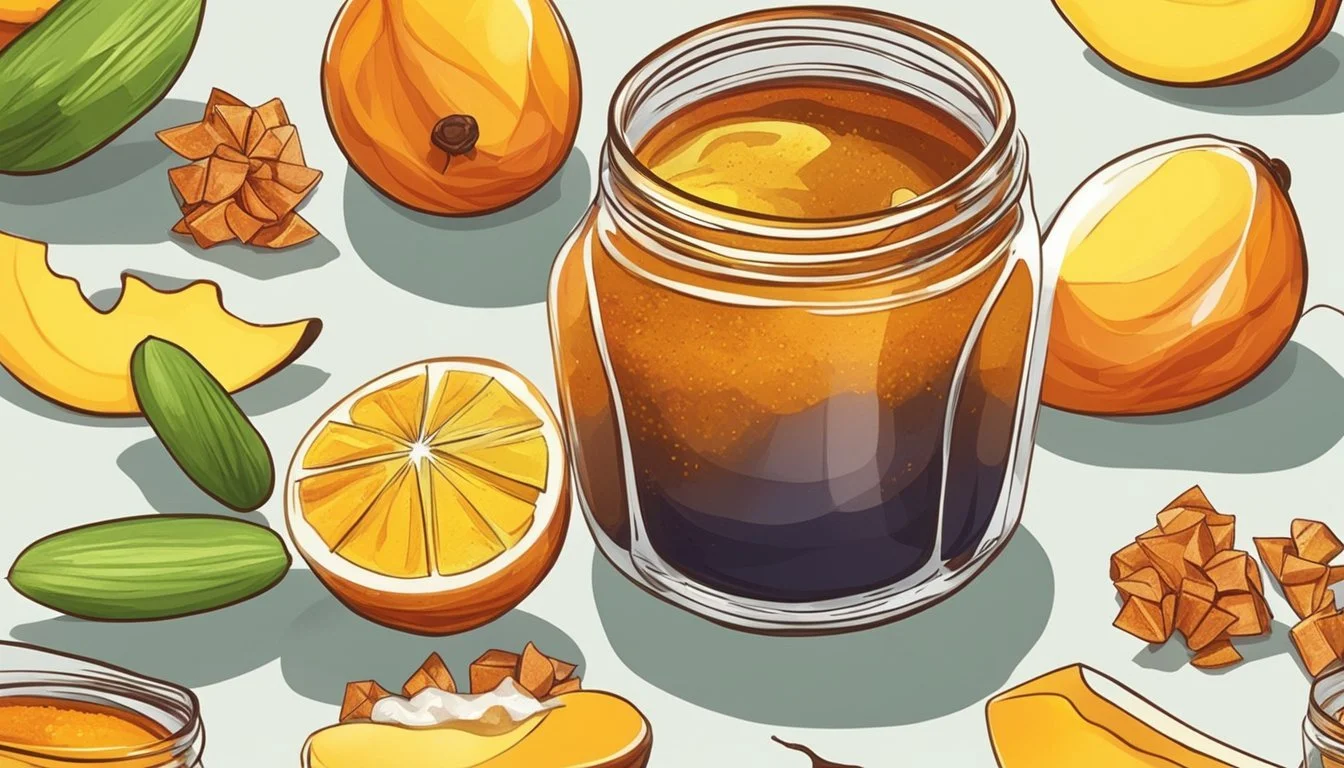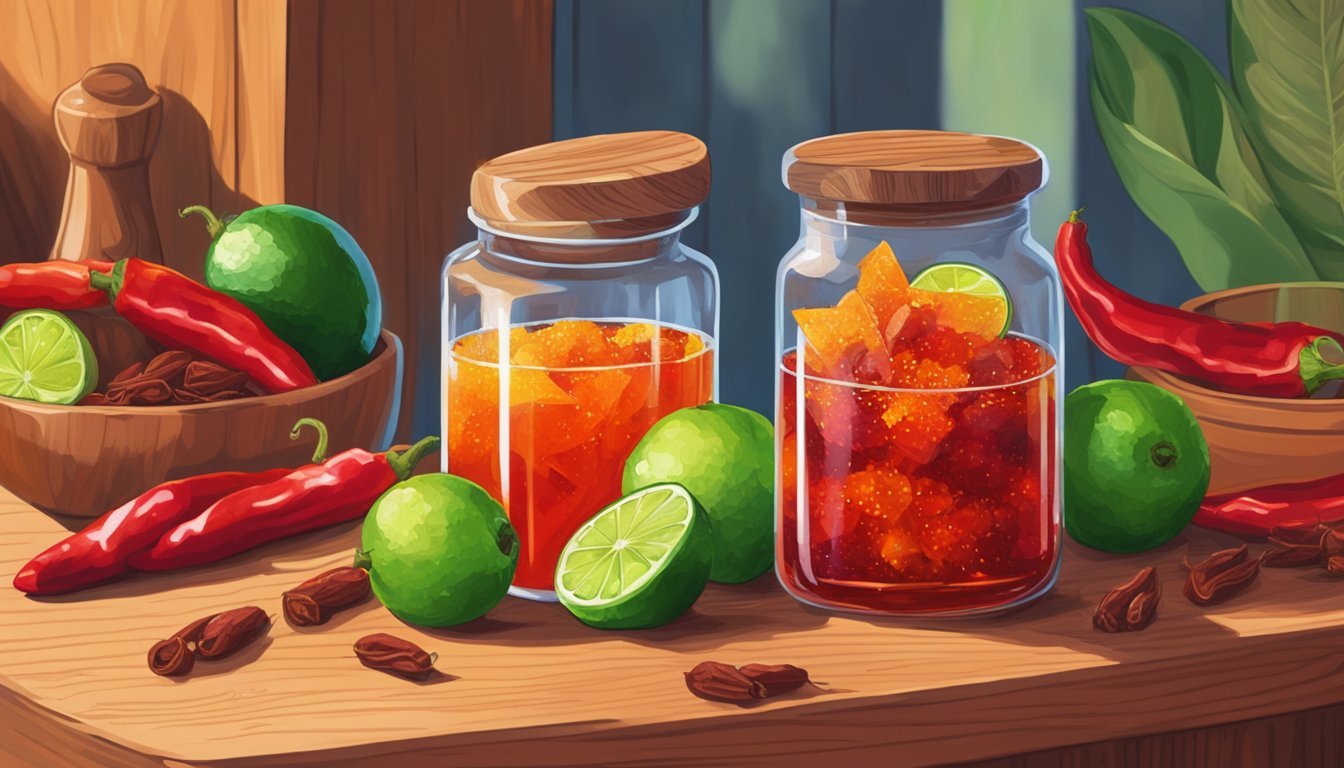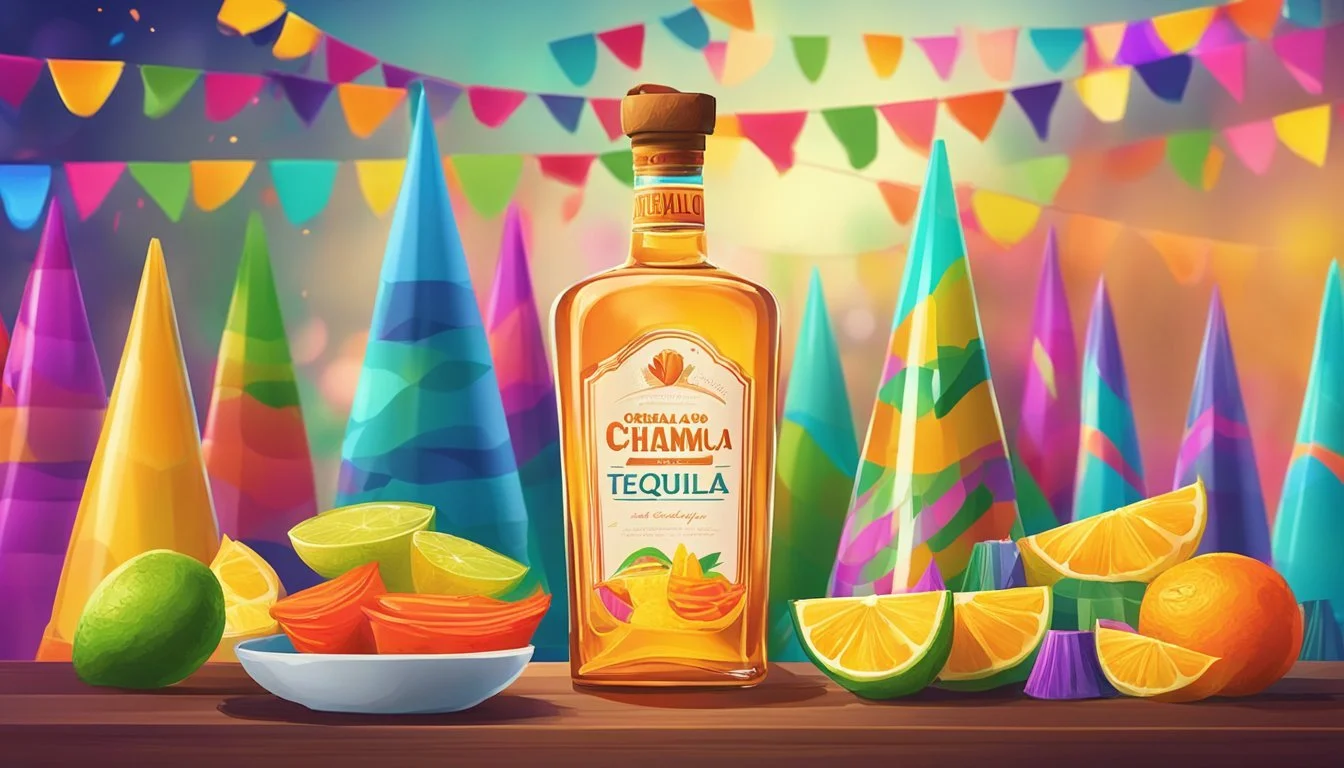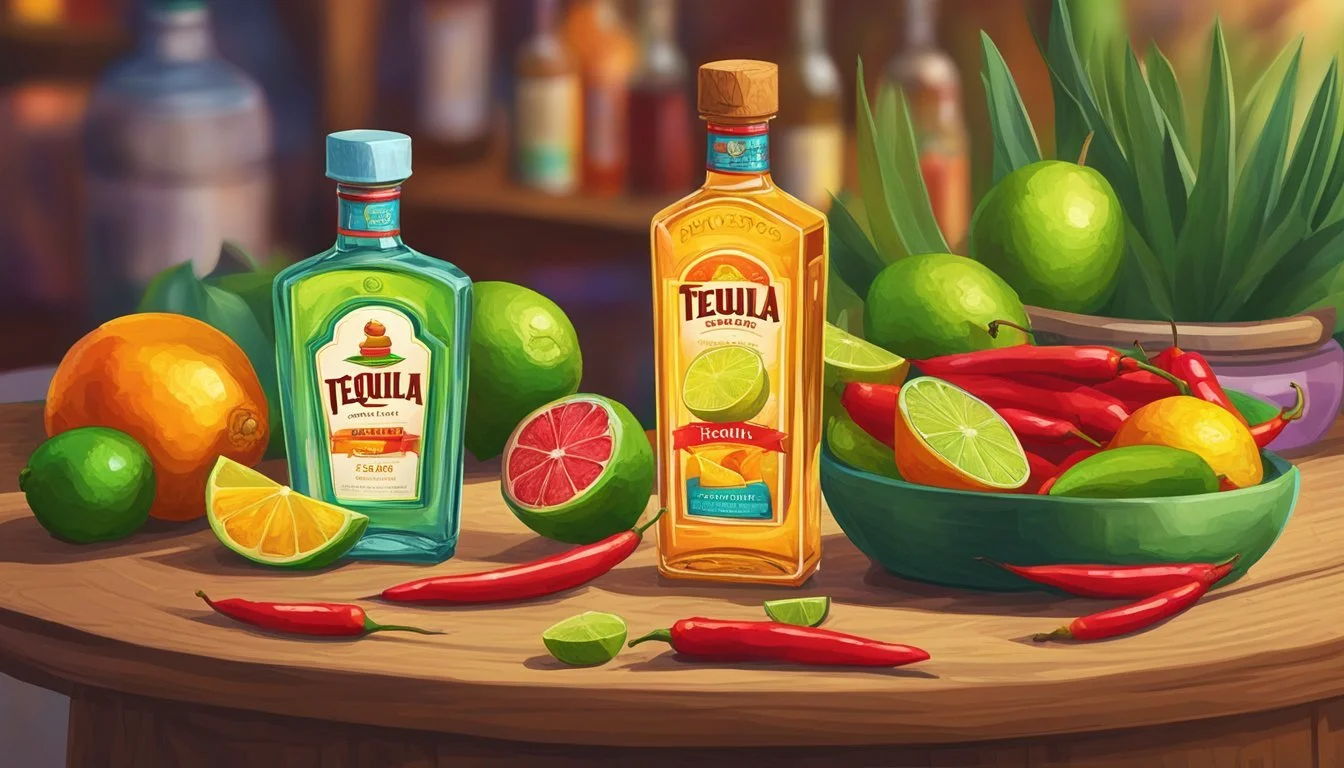Tequila and Chamoy
Unveiling Texas's Unique Cocktail Fusion
Tequila, a spirit steeped in rich Mexican heritage, has seamlessly mingled with the Texan culinary scene, carving out its niche among connoisseurs of fine drinks and social enthusiasts alike. Drawing from its roots, tequila serves as a versatile base for a variety of cocktails, one of which has garnered attention for its unique blend of sweet and spicy flavors. This is where chamoy comes in – a condiment typically made from pickled fruit mixed with chili powder, lime, and salt, delivering a flavor profile that tantalizes the palate with its sweet heat.
The combination of tequila with chamoy introduces a delightful contrast that's hard to miss in any social gathering across Texas. As tequila brings forth its smooth and often earthy undertones, chamoy layers an explosion of tanginess and subtle spice, creating an intricate dance of flavors. This pairing has elevated the traditional margarita to new heights, gaining popularity with each sip and setting the bar high for creative cocktail crafting.
Originating from the culinary innovation that Texas is known for, the sweet and spicy duo has increasingly become a staple at local bars and restaurants. It's not just in margaritas that this combination shines; it's also making a splash in a range of mixed drinks, leaving a memorable impression on both newcomers and seasoned cocktail aficionados. Whether served in a salt-rimmed glass or over ice, the marriage of tequila and chamoy epitomizes the adventurous spirit of the Lone Star State's beverage culture.
The Origins and Cultural Significance of Chamoy
Chamoy is intimately tied to Mexican cuisine's vibrant tapestry, yet its story begins across the Pacific. This piquant condiment owes its genesis to Chinese culinary practices, where pickling fruits like plum and apricot was commonplace. Over time, these pickled fruits took a new form as chamoy when they made their way to Mexico.
Ingredients and Variations
Traditional Fruit Base:
The most common fruits used are apricot, plum, and tamarind.
Spice:
Chile powder is blended into the mix to add heat.
In Mexico, chamoy has grown beyond its origins to become a definitive flavor — spicy, sour, sweet, and salty all at once, speaking volumes about the complexity of Mexican palates. It thrives as a versatile topping and an ingredient that can transform anything from fruits to beverages.
Availability
Chamoy's rise in popularity has led to its omnipresence in Hispanic grocery stores and markets, reflecting its staple status in Mexican homes and cuisine. Its cultural significance is marked by its ability to evoke nostalgia among its consumers, reminiscent of childhood and tradition.
Given its unique profile, chamoy continues to influence food experiences, signifying more than just taste — it represents culinary innovation and cultural fusion, standing testament to Mexico's rich food heritage and its global influences.
Demystifying Tequila
Tequila is a distilled spirit that originates from Mexico, steeped in tradition and regulation. It is made exclusively from the blue agave plant, primarily in the area surrounding the city of Tequila and in the highlands of the central western Mexican state of Jalisco.
Types of Tequila:
Tequila Blanco: Also known as silver tequila, this type is bottled immediately after distillation or aged less than two months in stainless steel or neutral oak barrels.
Añejo: This tequila is aged in oak barrels for one to three years, acquiring a darker color and richer flavor.
Each type offers a different experience. Tequila Blanco boasts a pure agave flavor, while añejo presents a smoother, more complex profile.
Agave Distinction:
Agave used in tequila is specifically Agave tequilana, or blue agave.
Tequila is often confused with mezcal, another agave-based spirit. While both come from agave, they differ in flavor, production methods, and types of agaves used. Mezcal can be produced from over 30 types of agave and is typically characterized by a smoky flavor.
Tequila production is governed by strict regulations to maintain quality and authenticity. The spirit must be produced in designated regions of Mexico and must contain at least 51% blue agave, though premium brands often boast 100% agave.
Understanding these key factors demystifies tequila, showcasing its richness and variety. As a cultural symbol and artisanal product, tequila continues to be a source of pride for Mexico and a beloved spirit worldwide.
Key Ingredients and Flavor Profile
When crafting the quintessential Tequila and Chamoy cocktail, the ingredients are selected to create a complex flavor profile that is at once sweet, spicy, sour, and savory. Each ingredient contributes its unique characteristics to the final taste experience.
Tequila: The foundation of the cocktail, tequila brings a robust and earthy flavor that can range from sweet and smooth to spicy and bold, depending on the aging process. It typically imparts a slight umami character which is central to the cocktail’s personality.
Chamoy: This versatile Mexican condiment is made from pickled fruit such as apricot, mango, or plum, and it delivers a sweet, tangy, and spicy flavor. It provides a savory complexity characterized by its combination of sour and sweet notes along with a spicy kick from chili peppers.
Lime Juice: Fresh lime juice is essential for its bright acidity and tartness, balancing the sweetness of the chamoy and the strong notes of the tequila.
Agave Nectar: A natural sweetener derived from the same plant as tequila; it enhances the cocktail with a refined, earthy sweetness that underscores the agave in the tequila.
Salt: A pinch of salt can highlight the sweet and sour components and provide a counterbalance to the spiciness, bringing out the full flavor spectrum.
The resulting flavor profile of a Tequila and Chamoy cocktail is a harmonious blend, with a sugar-salt rim often added to accentuate these contrasting yet complementary flavors. Vinegar may also influence the profile subtly, contributing to the overall sour note present in the chamoy. This intricately layered taste profile caters to those who appreciate a cocktail experience that is vibrant and full of dimension.
Tequila-Based Beverages
Tequila has served as a versatile foundation for a multitude of beverages, ranging from the classic margarita to innovative creations like chamoyadas. With this spirit at the core, each concoction balances sweetness, spiciness, and acidity to create distinct flavors beloved in Texas and beyond.
Crafting the Perfect Margarita
The secret to a sublime margarita lies in its ingredients and proportions. Typically, a margarita consists of tequila, lime juice, and orange liqueur—such as Cointreau or triple sec—with a ratio favoring more tequila and lime juice to ensure a tart kick. Simplicity here allows the quality of the tequila to shine. For the finishing touch, rimming the margarita glasses with salt enhances the drink's flavor profile.
Essential Components:
Tequila: 2 oz
Lime Juice: 1 oz
Cointreau/Triple Sec: 1 oz
Simple Syrup (optional): 1/2 oz to taste
Mangonada: The Ultimate Fusion Drink
Mangonada blends the richness of a mango slush with the spicy-sweet tang of chamoy sauce. Originating from Mexican street food culture, this beverage embeds layers of flavor by incorporating orange juice and lime juice, which complements the tequila base. The mangonada is served in a chilled glass that has been rimmed with tajin seasoning, creating a playful mix of textures and tastes.
Key Ingredients:
Tequila
Mango: Fresh or frozen
Chamoy Sauce
Tajin Seasoning
Orange Juice
Lime Juice
Innovative Cocktails: Jalapeño Margarita and Chamoyadas
Innovative tequila cocktails such as the Jalapeño Margarita introduce a fiery dimension to the traditional margarita formula. Infusing tequila with sliced jalapeños adds a delicate heat that is mellowed by the coolness of the accompanying ingredients.
Jalapeño Margarita Components:
Jalapeño-infused Tequila
Lime Juice
Simple Syrup
Orange Liqueur
Chamoyadas, on the other hand, cleverly combine the traditional sweetness of shaved ice with the distinct tanginess of chamoy, producing a sweet and sour experience with an undercurrent of tequila warmth. It challenges and delights the palate, meshing sweet with spicy in a single balanced beverage.
Chamoyadas Elements:
Tequila
Chamoy Sauce
Shaved Ice
Fresh Fruit (typically mango or pineapple)
Tajin Seasoning
Combining Chamoy with Fresh and Dried Fruits
Chamoy sauce, with its sweet, tart, and spicy profile, pairs exceptionally with both fresh and dried fruits. It traditionally complements mango, especially the sweet and juicy varieties like honey mangos and ripe mangos. The sauce brings out the mango's natural vibrancy, making it a popular choice in Texas for an invigorating treat.
Fresh Mango
To utilize chamoy with fresh mango, one might start by slicing the fruit and drizzling it with the sauce. The combination of the luscious fresh mango texture and the savory tang of chamoy creates a delightful contrast.
Slice the mango into wedges or cubes
Drizzle with chamoy
Optionally sprinkle with Tajín for extra tang
Dried Fruits
As for dried fruit, chamoy pairs well with apricots and plums. The dehydration process concentrates the fruits' sugars, and chamoy adds a kick that elevates the taste.
Rehydrate dried apricots or plums slightly
Toss them in chamoy sauce
Table: Chamoy Pairings with Dried Fruits
Dried Fruit Preparation
Apricots Soak briefly, then toss in chamoy
Plums Lightly rehydrate, coat with chamoy
Pineapple
With pineapple, the enzyme bromelain naturally tenderizes the fruit, which can intensify the chamoy's flavor penetration. Pineapple chunks dipped in chamoy make for a zesty and succulent bit.
Ultimately, one's creativity can guide the use of chamoy with both fresh and dried fruits, whether it's in slices, dices, or as part of a fruit salad. The harmonious blend of spicy chamoy and sweet fruits is a testament to the classic Texan fusion of flavors – a simple yet sophisticated culinary delight.
Tequila and Chamoy in Mexican Cuisine
Tequila, a distilled spirit, and Chamoy, a savory sauce, hold distinct places in Mexican cuisine. Originating from the state of Jalisco, tequila is made from the blue agave plant and is integral to Mexican heritage and celebrations. Chamoy, on the other hand, encompasses a range of flavors—salty, sweet, sour, and spicy—made from pickled fruit, such as apricots or plums, blended with chiles and lime.
Snacks in Mexico often feature Chamoy as a key ingredient. It is common to find fresh fruit cups, typically street food favorites like mango or pineapple, dressed with Chamoy for a tangy kick. The versatility of Chamoy extends to various Mexican confections, including candies and paletas (popsicles).
In the context of tacos, one might not immediately associate Chamoy. However, innovative chefs and street food vendors have begun incorporating Chamoy into salsas or glazes for taco fillings, marrying the heat of tequila-based marinades with Chamoy's complex profile.
Chamoy Recipe Variations:
Classic: Pickled fruit, chili powder, salt, and lime juice
Modern Twist: Adding mango or tamarind for a fruity undertone
Mexican street food demonstrates the ubiquity of Chamoy and tequila. Besides snacks, beverages like margaritas are given a unique twist with Chamoy, aligning the refreshing qualities of tequila cocktails with Chamoy’s depth of flavor. These drinks are often rimmed with Tajín, a chili-lime salt, to elevate the tasting experience.
While tequila stands as a celebratory drink, Chamoy remains a go-to for an explosion of flavors in Mexican cuisine. Both are testimonies to Mexico's rich gastronomic landscape, expressing tradition and modernity, sometimes even converging in a single serving—like in a mango Chamoy margarita.
Homemade Chamoy: Variations and Recipes
Chamoy sauce, a dynamic Mexican condiment, pairs exquisitely with the robust flavor of tequila. Its balance of sweetness, spice, and tartness enhances beverages and snacks alike. The basic chamoy recipe involves a fruit base, such as apricot or plum, combined with lime juice, chilies, and a sweetener.
Classic Chamoy Sauce
Apricots or plums
Lime juice
Ancho or guajillo chilies
Sugar or honey
This sauce can be tailored. For a sweeter version, one may opt for honey or maple syrup instead of traditional sugar. Honey offers a rich, floral sweetness, while maple syrup provides a unique, caramelized flavor.
Sweet Variations
Substitute sugar with:
Honey: For a floral note
Maple syrup: For a caramel-like richness
For those desiring a deeper flavor, brown sugar is an excellent alternative; it lends a molasses depth to the sauce. Adding intricacies like garlic or ginger can transform the sauce into a savory delight, ideal for marinades or glazing meats.
Savory Twists
Add:
Brown sugar: For a deeper molasses note
Garlic or ginger: For a more complex savoriness
A popular twist incorporates a dusting of Tajín—a blend of chili powder, salt, and dehydrated lime juice—on the rim of the glass for a tangy, spicy kick with tequila shots.
Spicy Rim Suggestions
Rim the glass with:
Tajín: For an extra spicy tang
For those with an adventurous palate, a hint of chocolate can fuse with chamoy's spice to create a decadent, mole-like sauce, perfect for drizzling over desserts.
Dessert Enhancements
Incorporate:
Chocolate: To pair with desserts for a mole-like twist
In its approach, the sauce remains versatile, catering to a wide range of tastes and dish pairings, confirming chamoy as a beloved Texas staple when served with a shot of smooth tequila.
Chamoy as a Versatile Condiment
Chamoy boasts a multifaceted personality in the culinary world, thriving as a beloved Mexican condiment that encompasses a sweet, spicy, salty, and tangy flavor spectrum. It traditionally emerges from a mixture of pickled fruit, chili peppers, lime, and salt, which harmoniously meld to create its distinctive taste. Often, fruits like apricots, plums, or mangoes are utilized in its foundation, though variations could include other fruits.
In Texan cuisine, chamoy finds companionship with the iconic spirit of the state, tequila. While tequila stands tall with its robust and earthy notes, chamoy introduces a playful and complex layer. The versatility of chamoy sees it transitioning with ease from a simple garnish to a full-fledged salsa. In its more utilitarian form, chamoy can enhance snacks and beverages, serving not just as a condiment but also as an exciting flavor expansion mechanism.
Hot Sauce Alternative: Chamoy offers an exhilarating kick, resembling a hot sauce, but with added layers of sweetness and acidity.
Tajín Complement: When paired with Tajín, a popular Mexican seasoning, chamoy elevates fruits and cocktails with a lively zest.
Furthermore, this adaptable sauce can transform a dish's profile by acting as a marinade for meats, thereby infusing them with deep, complex flavors. Its resourcefulness extends into the beverage realm, particularly in Texas, where chamoy can be found lining the rims of glasses for an extra pop in spicy margaritas or micheladas.
Chamoy's multifunctionality in the kitchen underscores its role not merely as a condiment but as an inventive ingredient that dances across the palate, delivering a sensory experience that complements the robustness of Texas' famed spirit, tequila.
Pairing Suggestions: Drinks and Foods That Complement
A perfect blend of sweet and spicy, the union of tequila with chamoy offers a versatile palette for various drinks and food pairings.
Drinks
For a refreshing Michelada, one can infuse chamoy around the rim before combining chilled beer, lime juice, and tequila. This concoction transforms the traditional Mexican cerveza preparada into a vibrant flavor ensemble.
Tacos
Tacos served with a drizzle of chamoy sauce add a unique twist. Whether opting for fish, carne asada, or carnitas, the sauce complements the savory fillings and the crispness of fresh vegetables.
Frozen Mango and Sorbet
Frozen Mango treated with a sprinkle of chamoy offers a tantalizing treat balancing icy freshness with piquant zest.
Sorbet with chamoy swirls creates a fruity dessert with a kick, excellent for cleansing the palate post-meal.
Street Food
Popular elements in Mexican street food, like elotes (corn on the cob) or fruit cups, pair exceptionally well with chamoy's robust profile.
Pairing Item Description Suggested with Chamoy
Micheladas Beer-based cocktail, tangy and effervescent For the rim
Tacos Staple Mexican dish, varies in fillings As a topping
Frozen Mango Chilled fruit, a sweet snack Sprinkled on top
Sorbet Light, fruit-based dessert Swirled in
Street Food Casual, often on-the-go eats As an accompaniment
These pairings showcase chamoy's flexibility, enhancing the agave spirit's nuanced flavors, and crafting invigorating taste profiles suitable for a range of tastes and occasions.
Crafting Your Own Tequila and Chamoy Creations
Creating the perfect blend between the robust flavors of tequila and the tangy zest of chamoy requires both creativity and a fundamental understanding of how these flavors complement each other. This sweet and spicy combination popular in Texas has become a staple in various Mexican-inspired beverages and treats.
Key Ingredients:
Tequila: Preferably a clear variety such as Blanco for a crisp taste
Chamoy: A savory sauce made from pickled fruit, chilies, and lime
Mango: Fresh or frozen, essential for the fruity base in mangonadas and margaritas
Lime: Adds the necessary acidity to balance the sweetness
Mango Chamoy Margarita:
One can craft their mango chamoy margarita using their trusty blender. They would start by rimming their glass with chamoy and dipping it in Tajín to add a chile-lime flavor. They would then blend the following:
2 oz Blanco tequila
1 cup diced mango (fresh or frozen)
1 oz fresh lime juice
1/2 oz orange juice
Ice cubes
A dash of chamoy to taste
Pour the mix over ice and garnish with a slice of lime or a small mango wedge.
Mangonadas and Chamangos:
For frozen treats like mangonadas or chamangos, blending is key. They combine mangoes, chamoy, and ice to create a slushy consistency. Here's a simple table to break down the process:
Step Action
1 Cube mangos; freeze if preferred
2 Blend mangos with ice to slushy texture
3 Incorporate chamoy to taste
4 Serve in glasses with chamoy and Tajín rim
Moreover, those who wish to enjoy a non-alcoholic treat can simply leave out the tequila from their creations to savor the sweet and spicy fusion that chamoy adds to their palate. By experimenting with these ingredients, individuals have an avenue to explore the flavors that define Tex-Mex cuisine in a refreshing and delightful way.
Food Pairings for Tequila and Chamoy
Tequila and Chamoy, a blend of sweet and spicy, is a versatile combination that pairs exceptionally well with a variety of foods, enhancing flavors and tantalizing taste buds.
Fresh fruit is a natural partner for the Tequila and Chamoy duo, especially with the contrast of the sweetness of the fruit against the heat of Chamoy. They often select tropical fruits like mango or pineapple to create a mouth-watering balance.
For snacks, they consider options that can stand up to the boldness of Chamoy. Here's a brief list of snacks that complement the spicy kick of Chamoy with Tequila:
Spiced Nuts: Almonds or peanuts with a pinch of chili powder
Popcorn: Tossed with Chamoy sauce for a tangy twist
Vegan food lovers aren't left out when it comes to Tequila and Chamoy pairings. They might opt for grilled vegetables or tofu marinated in Chamoy and soy sauce, which provides a smoky and savory contrast to the sweetness and spiciness.
Wings are a favorite for those who prefer a non-vegan option. They enjoy chicken wings glazed with a Chamoy-based sauce, providing a sticky, sweet, and spicy flavor that's both indulgent and satisfying when washed down with Tequila.
Lastly, Chamoy's taste profile includes notes of soy sauce, which could inspire fusion-inspired dishes such as Chamoy marinated sushi or a Tequila-infused stir-fry, opening a realm of possibilities for bold flavor combinations.
Incorporating these pairings, diners experience an interactive and vibrant culinary journey that is both memorable and delectable.
Storing and Preserving Chamoy for Longevity
Chamoy, a versatile Mexican condiment, is celebrated for its complex flavor profile, deriving from ingredients like pickled fruits, dried apricots, and often tamarind candy. Preserving its unique taste is key to enjoying chamoy over time. Here's how to store chamoy effectively to maintain its quality and extend its shelf life.
Temperature:
Chamoy thrives at stable temperatures. It should be stored between 50°F to 70°F (10°C to 21°C) to keep its flavors intact. Extreme temperatures should be avoided as they can spoil the pickled fruit base and alter the condiment's texture.
Airtight Containers:
Chamoy's consistency can be affected by exposure to air and moisture. To prevent this, one should place chamoy in an airtight container. Glass jars or bottles with tight-fitting lids are preferred for their non-reactive nature and ability to maintain the condiment's flavor profile.
Accessibility:
While chamoy is robust, it is essential to keep it in an easily accessible place. This ensures its regular usage, further incentivizing proper storage practices.
When properly stored, chamoy maintains its signature sweet, sour, spicy, and salty taste that it is known for, while also allowing for a variety of uses, from enhancing tamarind candies to providing a zesty topping for dried apricots. By following these simple storage guidelines, chamoy aficionados can ensure that each taste of this beloved condiment is as vibrant as the last.
Tequila and Chamoy in Social Gatherings
In the heart of Texas, particularly in bustling cities like San Antonio, the fusion of tequila and chamoy has become a staple for social events, especially during the scorching summer months. Guests often seek refreshment and respite from the summer heat, and these ingredients offer a distinctively Texan solution.
Tequila, a spirit with deep roots in Mexican culture, has been embraced by Texans with enthusiasm. When blended with chamoy, a sweet and spicy condiment made from pickled fruit, it creates a beverage that is both invigorating and flavorful. The combination is particularly popular on hot summer days, striking a balance between the warmth of the alcohol and the cool, tangy taste of chamoy.
Social gatherings in Texas frequently feature a variety of chamoy-infused drinks, with the Mangonada Margarita being a sought-after choice:
Ingredients:
Frozen mango
Tequila
Lime juice
Chamoy sauce
Tajin seasoning (for rim)
These ingredients are blended and often served in glasses with chamoy and tajin-rimmed edges, adding an aesthetically pleasing and tasty touch to the presentation.
One finds that at backyard barbecues, pool parties, and family reunions, hosts take pride in serving these unique concoctions. They provide not only a delightful beverage option but also a conversation piece, as many guests are intrigued by the combination of sweet, sour, and spicy flavors that are encapsulated in a single glass.
The growing popularity of such drinks demonstrates the cultural blend common in Texas, where locals enjoy incorporating diverse flavors into their social festivities, creating a communal atmosphere that is both welcoming and distinctly Texan.
Health Considerations and Dietary Notes
When incorporating tequila and chamoy into beverages or dishes, it is important to note the nutritional aspects and dietary implications of these two components.
Chamoy is traditionally plant-based and suitable for those following a vegan diet. Its primary ingredients include pickled fruit, chili peppers, lime juice, and salt. However, consumers should be aware of its caloric and sodium content which can vary based on preparation methods. Chamoy that is homemade or labeled as low-sodium provides better control over these dietary elements.
Tequila, derived from the agave plant, is a distilled alcoholic beverage. It contains calories that come exclusively from alcohol, with an average of around 64 calories per one-ounce shot. Tequila does not contain fat or sugar, except for any flavorings or sweeteners that may be added to certain brands or cocktails.
For those cautious about sugar intake, it's important to recognize that many commercial chamoy products and tequila-based cocktails may contain cane sugar or other sweeteners to enhance flavor, thus raising the calorie count.
Component Considerations Dietary Relevance
Chamoy High in sodium; may contain Suitable for vegans; calorie-conscious individuals should
added sugars consume in moderation
Tequila Calorie content comes from alcohol Calorie-conscious individuals should consume in moderation;
generally vegan, barring added flavorings
Individuals should consume these products in moderation due to their calorie and sodium content. Those with specific dietary restrictions or health conditions should consult nutrition labels or their healthcare provider for personalized advice.
Availability and Shopping for Ingredients
When venturing to create the iconic Tequila and Chamoy cocktail, one must know where to source the key ingredients. Hispanic grocery stores are treasure troves for authentic items needed in this recipe. They tend to stock a wide array of spices and nectars that are essential to achieve that perfect sweet and spicy blend.
For the uninitiated, Tajín is a popular chili-lime seasoning that is frequently used to rim glasses for this cocktail. Its tangy and spicy flavor profile complements the sweetness of the liqueur and Chamoy. One can easily find Tajín in Hispanic markets, as well as larger supermarkets in the international aisle.
Agave nectar, a natural sweetener derived from the same plant as Tequila, is a must-have to balance the spiciness. Its availability is widespread; shoppers can locate it in health food stores, large supermarkets, and of course, Hispanic grocery stores.
For a fruity touch, mango nectar serves as a sumptuous addition to the cocktail. It imbues a tropical essence that harmonizes with the savory Chamoy sauce. Mango nectar is available in most grocery stores, often found in the juice aisle or the ethnic foods section.
Below is a simplified guide for quick reference:
Ingredient Availability Notes
Tajín Hispanic grocery stores, larger supermarkets Chili-lime seasoning perfect for rimming
Agave Nectar Health food stores, large supermarkets, Natural sweetener; balances spiciness
Hispanic grocery stores
Mango Nectar Grocery stores (juice aisle/ethnic foods section) Adds a fruity, tropical layer to the cocktail
Chamoy Sauce Hispanic grocery stores, online retailers Essential for the unique sweet and spicy kick
Shoppers should ensure that labels are checked for quality and authenticity, allowing for a more genuine and flavorful Tequila and Chamoy experience.
The Future of Tequila and Chamoy in Mixology
In the realm of mixology, Tequila has found its sweet and spicy companion in Chamoy, especially in Texas where both ingredients are popular. The innovative mingling of Tequila's robust flavors with Chamoy's tangy and spicy qualities is shaping future cocktail trends.
Mangonada Margarita is a particularly exciting creation that showcases this fusion. Traditionally made with mango, lime, and Tequila, the addition of Chamoy introduces a sweet heat that elevates the drink. In the coming years, mixologists may further experiment with the Mangonada Margarita, possibly incorporating different types of Tequila or varying the fruit base to complement Chamoy’s complex profile.
Another notable contender in the spicy cocktail scene is the Jalapeño Margarita. The clear, piquant flavors of jalapeño peppers counterbalance the sweetness of agave in Tequila, providing a vibrant tasting experience. Future variations might include Chamoy for an added layer of sweetness and a unique decoration along the glass rim, marrying the heat of jalapeños with the sweet and salty kick of Chamoy.
Trending Ingredients Potential Impact on Mixology
Chamoy Increasing interest in complex, layered flavors
Jalapeño Demand for spicier, bolder cocktail experiences
As patrons become more adventurous with their palate preferences, they seek out distinctive flavor combinations. The union of Tequila with Chamoy is a testament to this evolving dynamic, with the certainty that mixologists will continue to innovate and refine upon these foundations.
The expectations for Tequila and Chamoy in mixology remain high, with a clear trajectory towards more sophisticated and intricate beverages. Bars and restaurants might anticipate these trends by diversifying their cocktail menus, incorporating new Tequila infusions, and offering a range of Chamoy-accented drinks to cater to a broad audience.
Conclusion
Tequila and chamoy represent a fusion of flavors that has gained popularity in Texas, reflecting the state's love for bold and diverse tastes. This combination showcases a unique synergy:
Tequila: A versatile spirit that serves as a robust base for various cocktails.
Chamoy: A condiment with a complex flavor profile—sweet, salty, sour, and spicy—that complements the zest of tequila.
When these two elements come together, they create an experience that is both refreshing and exhilarating. A chamoy rim on a tequila-based cocktail glass adds a flavorful twist that enhances the drinking experience. Used in margaritas or even in a simple tequila shot, chamoy introduces an extra layer of depth to the drink.
Texans have embraced the sweet and spicy combination as a testament to their culinary innovation and cultural blending. The adaptability of chamoy allows it to be paired with a variety of fruits and seasoning, thus giving bartenders and enthusiasts the freedom to experiment with new and exciting drink creations.
As the popularity of tequila and chamoy continues to rise, one can expect to see more creative infusions of this bold duo across bars and households. This combination is more than just a trend—it's a celebration of flavor, heritage, and the spirit of Texas itself.



